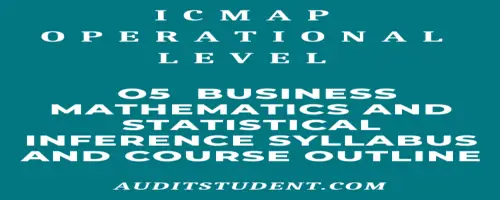Get access to latest and updated syllabus of O5 Business Mathematics and Statistical Inference now. Here you will find detailed course content or Syllabus of Business Mathematics & Statistical Inference for upcoming attempt.
Now you know what topics to study and practice .The next step would be to download the latest official Business Mathematics & Statistical Inference Text. Click
to Download.
Syllabus GRID:
Here is the grid of Syllabus of Business Mathematics & Statistical Inference.
| GRID | WEIGHTAGE |
| 1 Basic Mathematical Techniques 2 Formulae and Equations 3 Derivatives 4 Compounding and Discounting 5 Basic Investment Appraisal | 40% |
| 6 Data and Information 7 Collection and Presentation of data 8 Averages 9 Dispersion 10 Correlation and Linear Regression 11 Index numbers 12 Probability 13 Normal distribution 14 Estimation & Testing 15 Sampling & Sampling Frequency Distribution 16 Forecasting – Time series | 60% |
| Total | 100% |
Detailed Syllabus Contents:
The detailed Syllabus of Business Mathematics & Statistical Inference for upcoming attempt is given below.
PART – A
BUSINESS MATHEMATICS
1. Basic Mathematical Techniques
- Integers, Fractions and Decimals
- Order of Operations
- Percentage and Ratios
- Roots and Powers
- Errors
2. Formulae and Equations
- Introduction
- Manipulating Inequalities
- Linear Equations, Linear Equations and Graphs, Simultaneous Equations
- Non-Linear Equations, Progressions
- Arithmetic Progression
- Geometric Progression (nth Terms and Sum)
- Matrices (Definition Sum and multiplication of two matrices)
- Use in Solving simultaneous, equators, Cramer’s rules
- Linear programming, Properties and using of programming for maximization of profit and minimization of cost.
3. Derivatives
- Concept of Derivative and differentiation
- Basic Rules of differentiation
- Instantaneous rate of change
- Derivatives, Maxima and Minima & Point of Inflection
4. Compounding and Discounting
- Simple Interest, Compound Interest, Equivalent Rates of Interest
- Regular Savings and Sinking Funds
- Loan and Mortgages
- Concept of Discounting
5. Basic Investment Appraisal
- Net Present Value (NPV) Method
- Internal Rate of Return (IRR) Method
- Annuities and Perpetuities
- Linking Compounding and Discounting
- Using Spreadsheet(Define Spread sheet, need to use of spread sheet, Define work book, work sheets and type of cell contents)
- Shareholder Value(define shareholder value and identify financial objectives to maximize shareholders wealth)
PART – B
STATISTICS AND STATISTICAL INFERENCE
6. Data and Information
- Introduction, Characteristics of Good Information, Data Type (Qualitative and Quantitative data, primary and secondary data, discrete and continuous data)
7. Collection and Presentation of data
- Tables, Charts, Frequency Distribution, Histograms, Ogives, Scatter Diagram
8. Averages
- Arithmetic Mean, Harmonic mean, Geometric mean, Mode, Median
9. Dispersion
- Range
- Quartiles and Quartile Range and Quartile deviation orthe Semi-Quartiles Range
- Mean Deviation
- Variance and Standard Deviation
- Coefficient of Variation
- Skewness
10. Correlation and Linear Regression
- Correlation
- Correlation Coefficient and Coefficient of determination
- Spearman’s Rank Correlation Coefficient
- Lines of Best Fit
- Scatter Graph Method
- Linear Regression Analysis
- Using Spreadsheets (Characteristics of a useful spread sheets, Advantage and disadvantage of spread sheets, inserting formula in excel, explain formula with conditions)
11. Index numbers
- Basic Terminology
- Index Relatives
- Time Series of Index Relatives
- Time Series Deflation
- Composite Index Numbers
- Weighted Index Numbers
- Retail Price Index for Pakistan
12. Probability
- Concept of Probability and counting techniques (including multiplication rules of counting, combinations, permutations, etc))
- Rules of Probability
- Expected Values
- Expectation and Decision Making
13. Normal distribution
- Probability Distributions(Discrete and continuous)
- Normal Distribution
- Standard Normal Distribution
- Binominal of passion distribution
- Hyper geometric distribution
- Using Normal Distribution to Calculate Probabilities
- Pareto Distribution and 80:20 Rule
14. Estimation & Testing
- Confidence Interval Z and T test for single population mean
- Testing hypothesis Z and T test for single population mean
- Chai square distribution
15. Sampling & Sampling Frequency Distribution
- Sampling Frequency Distribution with & without replacement for sample size 2 and 3
- Random and Non-Random Sampling
- Sampling Frequency distribution for proportion
16. Forecasting – Time series
- Components of Time Series (Define time series and identify its examples, preparing time series graphs and identifying trends)
- Finding the Trend (Methods, prepare trend equation using graphical means or regression analysis)
- Finding the Seasonal Variations (Define Season variations, finding the seasonal components using additive and multiplicative models)
- Forecasting (Define forecasting, forecasting using linear regression analysis)
Limitation of Forecasting Models
syllabus of O5 Business Mathematics and Statistical Inference:
syllabus of O5 Business Mathematics and Statistical Inference syllabus of O5 Business Mathematics and Statistical Inference syllabus of O5 Business Mathematics and Statistical Inference syllabus of O5 Business Mathematics and Statistical Inference syllabus of O5 Business Mathematics and Statistical Inference